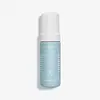What's inside
What's inside
 Key Ingredients
Key Ingredients

No key ingredients
 Benefits
Benefits

 Concerns
Concerns

 Ingredients Side-by-side
Ingredients Side-by-side

Water
Skin ConditioningCoco-Glucoside
CleansingGlycerin
HumectantCocamidopropyl Betaine
CleansingBetaine
HumectantPEG-7 Glyceryl Cocoate
EmulsifyingButylene Glycol
HumectantPanthenol
Skin ConditioningPaeonia Officinalis Flower Extract
TonicGinkgo Biloba Leaf Extract
Skin ConditioningCitrus Grandis Fruit Extract
AstringentSodium Chloride
MaskingCitric Acid
BufferingDisodium EDTA
Sodium Hydroxide
BufferingParfum
MaskingPhenoxyethanol
PreservativePotassium Sorbate
PreservativeSodium Benzoate
MaskingWater, Coco-Glucoside, Glycerin, Cocamidopropyl Betaine, Betaine, PEG-7 Glyceryl Cocoate, Butylene Glycol, Panthenol, Paeonia Officinalis Flower Extract, Ginkgo Biloba Leaf Extract, Citrus Grandis Fruit Extract, Sodium Chloride, Citric Acid, Disodium EDTA, Sodium Hydroxide, Parfum, Phenoxyethanol, Potassium Sorbate, Sodium Benzoate
Water
Skin ConditioningGlycerin
HumectantDimethicone
EmollientIsodecyl Neopentanoate
EmollientAlcohol Denat.
AntimicrobialSaccharide Isomerate
HumectantPanthenol
Skin ConditioningTocopheryl Acetate
AntioxidantLeontopodium Alpinum Extract
Skin ConditioningMentha Aquatica Extract
TonicIris Ensata Extract
Skin ConditioningFaex Extract
Skin ConditioningMalt Extract
Skin ProtectingAdenosine
Skin ConditioningViola Tricolor Extract
EmollientCryptomeria Japonica Bud Extract
Skin ConditioningHydrolyzed Ceratonia Siliqua Gum Extract
Lavandula Angustifolia Oil
MaskingThymus Mastichina Flower Oil
Skin ConditioningSalvia Officinalis Oil
MaskingEDTA
Polysorbate 60
EmulsifyingSorbitan Isostearate
EmulsifyingSodium Citrate
BufferingSodium Benzoate
MaskingLinalool
PerfumingLimonene
PerfumingGeraniol
PerfumingWater, Glycerin, Dimethicone, Isodecyl Neopentanoate, Alcohol Denat., Saccharide Isomerate, Panthenol, Tocopheryl Acetate, Leontopodium Alpinum Extract, Mentha Aquatica Extract, Iris Ensata Extract, Faex Extract, Malt Extract, Adenosine, Viola Tricolor Extract, Cryptomeria Japonica Bud Extract, Hydrolyzed Ceratonia Siliqua Gum Extract, Lavandula Angustifolia Oil, Thymus Mastichina Flower Oil, Salvia Officinalis Oil, EDTA, Polysorbate 60, Sorbitan Isostearate, Sodium Citrate, Sodium Benzoate, Linalool, Limonene, Geraniol
Ingredients Explained
These ingredients are found in both products.
Ingredients higher up in an ingredient list are typically present in a larger amount.
Glycerin is already naturally found in your skin. It helps moisturize and protect your skin.
A study from 2016 found glycerin to be more effective as a humectant than AHAs and hyaluronic acid.
As a humectant, it helps the skin stay hydrated by pulling moisture to your skin. The low molecular weight of glycerin allows it to pull moisture into the deeper layers of your skin.
Hydrated skin improves your skin barrier; Your skin barrier helps protect against irritants and bacteria.
Glycerin has also been found to have antimicrobial and antiviral properties. Due to these properties, glycerin is often used in wound and burn treatments.
In cosmetics, glycerin is usually derived from plants such as soybean or palm. However, it can also be sourced from animals, such as tallow or animal fat.
This ingredient is organic, colorless, odorless, and non-toxic.
Glycerin is the name for this ingredient in American English. British English uses Glycerol/Glycerine.
Learn more about GlycerinPanthenol is a common ingredient that helps hydrate and soothe the skin. It is found naturally in our skin and hair.
There are two forms of panthenol: D and L.
D-panthenol is also known as dexpanthenol. Most cosmetics use dexpanthenol or a mixture of D and L-panthenol.
Panthenol is famous due to its ability to go deeper into the skin's layers. Using this ingredient has numerous pros (and no cons):
Like hyaluronic acid, panthenol is a humectant. Humectants are able to bind and hold large amounts of water to keep skin hydrated.
This ingredient works well for wound healing. It works by increasing tissue in the wound and helps close open wounds.
Once oxidized, panthenol converts to pantothenic acid. Panthothenic acid is found in all living cells.
This ingredient is also referred to as pro-vitamin B5.
Learn more about PanthenolSodium Benzoate is a preservative. It's used in both cosmetic and food products to inhibit the growth of mold and bacteria. It is typically produced synthetically.
Both the US FDA and EU Health Committee have approved the use of sodium benzoate. In the US, levels of 0.1% (of the total product) are allowed.
Sodium benzoate works as a preservative by inhibiting the growth of bacteria inside of cells. It prevents the cell from fermenting a type of sugar using an enzyme called phosphofructokinase.
It is the salt of benzoic acid. Foods containing sodium benzoate include soda, salad dressings, condiments, fruit juices, wines, and snack foods.
Studies for using ascorbic acid and sodium benzoate in cosmetics are lacking, especially in skincare routines with multiple steps.
We always recommend speaking with a professional, such as a dermatologist, if you have any concerns.
Learn more about Sodium BenzoateWater. It's the most common cosmetic ingredient of all. You'll usually see it at the top of ingredient lists, meaning that it makes up the largest part of the product.
So why is it so popular? Water most often acts as a solvent - this means that it helps dissolve other ingredients into the formulation.
You'll also recognize water as that liquid we all need to stay alive. If you see this, drink a glass of water. Stay hydrated!
Learn more about Water